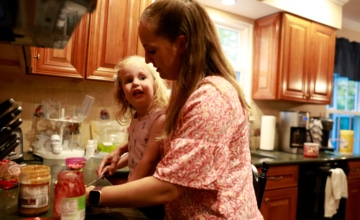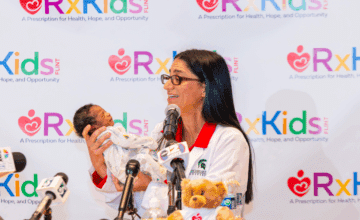Early identification of developmental issues, partnered with a system of supports to intervene, can prevent early challenges from compromising the child’s development.

When an infant is born and we look into his or her eyes, we can see the promise of a bright future for that child and for all of us. For some infants and toddlers, healthy development may not be a clear path, and intervention is needed to achieve that promise of a bright future. Occasionally, there are obstacles that compromise an infant’s growth—a medical condition, prenatal or birth trauma, or factors in the child’s environment. Many months may elapse between the time a problem or concern first emerges and when a child is enrolled in appropriate services, which can make a difference in the child’s developmental outcome.
Developmental screening programs identify children whose development may deserve closer observation or assessment and children who may be at risk of later developmental problems. Early identification of developmental issues, partnered with a system of supports to intervene, can prevent early challenges from compromising the child’s development. Building ongoing developmental screening into services that routinely have contact with infants, toddlers, and their families allows professionals to monitor and support children’s development. If screening raises concerns, children can be referred for in-depth evaluation and appropriate intervention to improve developmental outcomes. Policymakers can offer a bright future for infants and toddlers by ensuring that all children have access to developmental screening and that follow-up services are available for those children who need more detailed evaluation and treatment.
Approximately one of every seven children in the United States faces a developmental disability or a disabling behavioral problem before age 18. Yet fewer than 50% of these children are identified before they start school.
Policy Recommendations
1. Ensure that all infants and toddlers who are eligible for Medicaid and the Medicaid-expansion Children’s Health Insurance Program (CHIP) are enrolled and receive periodic developmental screening under the Early and Periodic Screening, Diagnosis, and Treatment (EPSDT) program, which includes physical, mental, and dental health.
Low-income infants and toddlers are more likely to have poor birth outcomes or experience physical and social-emotional challenges that can lead to developmental delays and disabilities. More than 25% of U.S. infants and toddlers live in poverty and are eligible for health services under public health programs such as Medicaid or CHIP. Medicaid mandates health and developmental screening through the EPSDT requirements. However, not every eligible child is enrolled, and even many enrolled children do not receive the full services to which they are entitled. In 2008, 40 states met the federal benchmark that at least 80% of the infants enrolled in Medicaid receive at least one developmental screening during their first year of life, and 44 states met the benchmark of two screenings for toddlers. Only five states have implemented the American Academy of Pediatrics (AAP) recommendation that infants receive seven well-child visits, during which ongoing screening and monitoring can take place. Ongoing monitoring is important because one in five children with a disability will not be identified through a single developmental screening. Disabilities are more likely to be detected if monitoring and screening are continued in all well-child medical care visits. State Medicaid managed care agreements and publicly funded children’s health plans should clearly outline required EPSDT services, screening frequency, and other screening mandates, and ensure that these important services are delivered to all eligible children. Children eligible for CHIP services should also receive EPSDT-like screening, diagnosis, and treatment services regardless of whether the state uses CHIP funds for Medicaid expansion or for a separate children’s health insurance program.
2. Require the use of standardized developmental screening tools through regulation, including tools that screen for issues in social-emotional development.
Some developmental issues may pass unnoticed during the early years, and some issues, especially relating to social-emotional development and behavioral health, are not identified early or easily without the help of standardized screening tools. The AAP recommends that surveillance be conducted at all well-child checkups (at 3–5 days of age, at 2, 4, 6, 9, 12, 15, 18, 24, and 30 months, and at the 3rd birthday). Developmental screening using a standardized screening tool should be conducted at 9, 18, and 30 months. Surveillance should consider parents’ concerns as well as risk and protective factors. These include family conditions, such as parental depression or alcohol or substance abuse, that impact the child’s development and security. Policymakers should make funding available to provide training and technical assistance to support professionals (pediatricians, home visitors, early care and education professionals, and others) to incorporate standardized screening tools into their contacts with infants, toddlers, and families. In addition, state Medicaid and CHIP regulations and private health care plans should spell out covered screening, diagnosis, and treatment services and identify appropriate screening tools.
3. Ensure that physicians and mental health professionals are reimbursed adequately for conducting screenings.
Physician reimbursements under private insurance or Medicaid/CHIP for well-child visits may be low, and pediatric care providers may have limited time to devote to surveillance and screening activities during well-child visits. Policymakers should ensure that reimbursement for well-child visits covers the time required to complete surveillance and screening along with other visit activities. Payment should also reimburse for screening as a separate activity whenever a concern is suspected between checkups. More favorable reimbursement rates for preventive care activities have been provided through 2014 under the Affordable Care Act (ACA), but funds will be needed to maintain this increase in the long term and to support state cost-sharing under ACA.
Poverty is a strong predictor of poor developmental outcomes in children. Low-income children are more likely than children from other income groups to have poor health and special health care needs that place them at risk of developmental delays. Yet these children are less likely to receive developmental screening.
4. Promote linkages between early identification services and a network of treatment services so that children’s developmental concerns are addressed.
Identifying a possible developmental concern is the first step to successful prevention or intervention. If health providers and others are linked in a network providing early identification, preventive and treatment services, and family supports, they can recognize developmental concerns early and respond to children’s needs. Some valuable linkages include coordinating care through a medical home; building relationships between pediatricians and local IDEA Child Find and intake services; strengthening information and referral networks; providing health and mental health consultation to child care providers and home visitors; and building collaboration between public health, child welfare, and early intervention services to ensure that children in the child welfare system are screened and referred. Funding should be provided to support increased service coordination, to increase community screening and referral networks through collaborative efforts such as Early Head Start, and to develop data systems that support tracking of children across service sectors.
Uninsured children are less likely to receive developmental screenings and preventive health care than children enrolled in public insurance programs such as Medicaid or the Children’s Health Insurance Program (CHIP).
5. Support outreach to inform parents about developmental screening and follow-up services.
Many parents seek assurance that their children are developing on a typical path, yet they may not understand the purpose of developmental screening. If they have a concern, they often do not know where to go for help. Community helpers who enter the lives of infants and toddlers (for example, child care providers, parent educators, home visitors, and health clinic staff) should understand that services are available for developmental screening, assessment, and treatment and should be able to provide information about these services. Funds should be provided to raise awareness and conduct outreach campaigns to educate community providers and increase family participation in screening activities.
Key Definitions
Surveillance or monitoring refers to the ongoing process of observing a child’s development and tracking parents’ concerns.
Developmental screening is the process of identifying children who may have a developmental problem or a delay in one or more domains of development, or who are at risk of developmental problems in the future. Comprehensive developmental screening should include consideration of the child’s physical, cognitive, language, and social-emotional development and risk factors in the child’s background.
Standardized screening tools are measures that gather evidence indicating the probability of or potential for a developmental problem, delay, or risk. Assessment is a more intensive process that evaluates the child’s development in depth in order to identify a specific developmental problem and to determine whether the child could benefit from intervention.
Early and Periodic Screening, Diagnosis, and Treatment (EPSDT): Under Medicaid, every eligible child is entitled to periodic developmental screening and treatment for diagnosed conditions to ensure that physical and mental conditions that could affect development are identified and corrected. The screening component includes keeping a health history and conducting a physical exam; laboratory tests; developmental and mental health screening; and dental, vision, and hearing screening.
Policymakers should ensure that reimbursement for well-child visits covers the time required to complete screening and other visit activities.
Child Find: The Individuals With Disabilities Education Act (IDEA) requires that states create a system to “find” children from birth to 3 years of age who may be eligible for services provided under Part C of IDEA, and children ages 3–18 years for Part B services. Child Find systems must coordinate with other state agencies and systems in efforts to identify children in need of services.
Research
Early investments have significant benefit to children and to society at large. An example of this long-term benefit is found in the test to detect congenital hearing problems in newborns. This simple test allows children to be identified beginning in the first months of life. Early treatment may prevent severe disabilities in communication and language development. Although the incidence of congenital hearing problems is low, its personal and economic cost is great. The Centers for Disease Control and Prevention estimates that the cost of providing special education services to a child with significant hearing loss is $11,006 per year. Early detection and treatment could greatly reduce this expense. Children whose hearing loss is detected in infancy and who receive treatment services have better language outcomes at 8 years of age. This in turn is linked to better educational outcomes and enhanced lifelong productivity. The newborn hearing screening test has been mandated in 43 states, and it is one of the 30 newborn screening tests recommended by the March of Dimes.
Low-income children are at greater risk of developmental delays and problems. Low-income children are more likely to face a number of risks that make them more vulnerable to health and development problems. These risks include parental depression, poor housing conditions (contributing to problems like lead poisoning or asthma), and nutrition deficiencies. In addition, the greater risk of exposure to substance abuse in the family, child abuse or neglect, or family disruption among low-income families puts children at greater risk of long-term problems in health and behavior. These risks could be detected and addressed through comprehensive screening and follow-up programs. While the number of low-income children covered by Medicaid or CHIP grew steadily in the early 2000s through CHIP expansion programs, low-income children still continue to face barriers to care such as frequent eligibility redetermination; lowered eligibility ceilings; shortages of participating pediatricians, dentists, and specialists; language barriers; and challenges due to immigration status. Their mothers are less likely to receive adequate prenatal care and screening for perinatal depression. In the current fiscal climate, states are shrinking eligibility for health services and early intervention programs or increasing families’ out-of-pocket expenses, making preventive care, screening, and treatment programs even less available for vulnerable families.
Only 5 states meet the standard for frequency of well-child checkups in the first year of life as recommended by the American Academy of Pediatrics for monitoring the infant’s health and development.
Training and support for pediatricians can improve screening rates and practices. The Assuring Better Child Health and Development (ABCD) project, designed to incorporate developmental monitoring and screening into pediatric practices and link pediatricians to referral networks, has significantly increased the occurrence of developmental screening and adoption of validated screening tools across the participating states. The project has also demonstrated strategies for taking these best practices to scale and made policy recommendations to improve practice statewide, such as revising Medicaid payment policies and training health providers on billing procedures so that reimbursement for screening activities was adequately covered. New voluntary benchmarks for use by Medicaid and CHIP programs to track health care quality will support states’ efforts to improve screening practices.
For a list of citations, download the full PDF.




